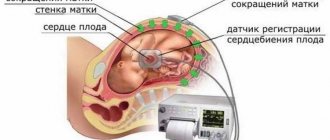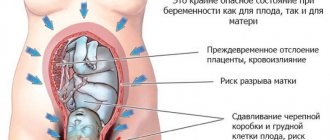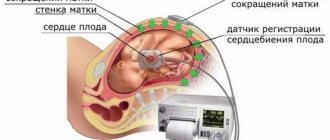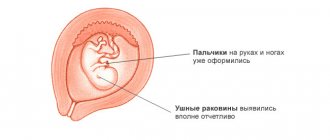Umbilical cord: complications during pregnancy
The main complications associated with the umbilical cord during pregnancy are:
- Umbilical cord cysts
- Umbilical cord knots
- Vasa presentation
Umbilical cord cysts are usually detected by ultrasound scanning. If this is the case, you may need further testing to check for birth defects in your baby. They often go away on their own and do no harm.
Umbilical cord knots are especially common if you're carrying twins—or if the umbilical cord just happens to be particularly long. Although they are rare, they can cause a baby's oxygen levels to decrease. Nodules may be detected during pregnancy scans and you may need a caesarean section to ensure your baby is born safely.
Vas previa is a pregnancy condition in which blood vessels from the umbilical cord or placenta cross the membranes covering the cervix, which is extremely rare (affecting less than 1% of births) and can be detected during pregnancy scans. Because this can cause life-threatening bleeding in your baby during or before labor, you will need to be monitored and will likely give birth via cesarean section.
Umbilical cord entanglement: consequences for the child
If, during the entire period of gestation, the child was unable to unravel the knots on his own, then the obstetrician-gynecologist, before giving birth, looks for the most suitable method for this.
There are several types of entwining the child's body with the umbilical cord , which do not in any way affect the development of the fetus. For example, if there is a weak single or double entanglement, a woman may well give birth naturally. After the birth of a child with such a pathology, the doctor will unravel the knots on the child’s body.
But in addition to simple knots, there are complex knots , due to which the baby can suffer, this includes repeated and tight entanglement. These types of entanglements can cause symptoms of hypoxia or symptoms of asphyxia (suffocation of the fetus). To avoid such consequences, the obstetrician may prescribe a caesarean section.
Due to insufficient oxygen supply to the baby’s body due to the twisting of the umbilical cord, he can suffer quite severely . After suffering from hypoxia, a child may develop symptoms accompanied by general lethargy of the whole body. Well, those babies who experienced signs of hypoxia in the womb may experience symptoms of lack of oxygen after birth. They may also have breathing problems and poor reactions to surrounding events.
Currently reading: Smoking during pregnancy
If a baby develops health problems after suffering from hypoxia, the doctor prescribes additional treatment procedures, after which the child’s condition can improve dramatically. Concern and fear should appear after tight and repeated entanglement, as well as after strong tension of the umbilical cord.
Umbilical cord: complications during childbirth
Major complications associated with the umbilical cord during childbirth include:
- Umbilical cord around the neck
- Umbilical cord prolapse
The umbilical cord may wrap around your baby's neck while you give birth. This is not uncommon and can usually be easily resolved by your doctor, who will untangle it or release it fairly quickly. If it is wrapped particularly tightly, it may affect the amount of oxygen reaching your baby. Your doctor will detect this from your baby's heart rate during labor. If he is concerned about this, it may require intervention (such as forceps, ventouse, or an emergency caesarean section) to get your baby out quickly.
Umbilical cord prolapse is extremely rare, but it can occur and lead to birth defects, cerebral palsy, or even stillbirth if not dealt with quickly. This is caused by a problem with the umbilical cord, which can sometimes slip through the entrance of the uterus before the baby is born, or it can be wrapped around the baby and tied in a knot.
wrapping the umbilical cord around the neck once
Umbilical cord entanglement around the fetal neck, umbilical cord knots, hypoxia - what is the reason? During pregnancy, the umbilical cord is formed simultaneously with the placenta and serves to connect mother and fetus - oxygen and nutrients flow through two arteries to the developing child, and waste products leave through a vein. Normally, the length of the umbilical cord is from 40 to 60 cm with a thickness of 2 cm. Reasons for the umbilical cord entwining around the fetal neck As the fetus moves inside the amniotic sac, it can twist and get caught in the knot formed by the umbilical cord - more often it wraps around the neck, sometimes around the arms and legs Umbilical cord nodes are divided into true (rare, in 2-3% of cases) and false (in all other cases). False nodes are bump-like varicose thickenings of the umbilical cord or its folds, which look like nodes on ultrasound. You can study the umbilical cord using ultrasound from the 17th week of pregnancy. Why does umbilical cord entanglement occur during pregnancy? Even very young people have probably heard about ancient beliefs that a pregnant woman should not knit or weave anything - this is what causes the umbilical cord to wrap around the fetus’ neck. Of course, this is nonsense. During pregnancy, fetal movements in the uterus are sometimes very intense. It is then that he can slip his head into the loop of the umbilical cord, and the umbilical cord will wrap around the fetal neck. The probability of this is low, which is why true loops are rare. Is it dangerous for the umbilical cord to wrap around the fetus's neck? Double or multiple entanglements of the umbilical cord around the fetal neck are dangerous. A single dose is not considered a pathology at all. Increased movements and their intensity may indicate maternal anxiety or hypoxia, i.e. lack of oxygen, this is the reason for the appearance of loops and entanglement in the umbilical cord. Since the baby does not breathe through the lungs before birth, slight compression of the neck will not harm the fetus before birth. Danger is likely only at the moment of birth. Therefore, even when diagnosing a true node or double entanglement of the umbilical cord, and this can be done using not only ultrasound, but also Doppler, doctors use a wait-and-see approach. The fetal heartbeat is monitored, and if there is no hypoxia in the fetus, labor is not accelerated. Double or more entanglement of the umbilical cord around the neck is an indication for delivery by surgery at 37 weeks, and if the condition of the fetus is impaired, even earlier. In other cases, a woman gives birth on her own, and the diagnosis of umbilical cord entanglement around the neck is not made while the amniotic sac is intact - after all, the baby can untwist itself in the same way as it twisted. At the same time, the child’s condition is carefully monitored so that at the first signs of fetal distress, delivery can be accelerated - perhaps induction of labor will be necessary, perhaps at the beginning of the process, and surgery. When the head appears from the birth canal, the loops of the umbilical cord wrapped around the neck are removed - and nothing is scary anymore! Thus, preventing the umbilical cord from becoming entangled around the fetal neck is simple. It is necessary to have sufficient exposure to the air, avoid smoking and being in a stuffy room, less worry and more walking for the expectant mother. And you can calmly wait for the birth; being entangled in the umbilical cord is no longer so scary.
Cutting the umbilical cord: how long to wait?
Once you give birth, the umbilical cord connecting you to your baby should be cut. Until recently, cutting the umbilical cord immediately after the baby was born was standard practice. However, research now shows that cutting the umbilical cord too soon can mean that newborns lose a significant amount of oxygen and iron-rich blood, which continues to flow through the umbilical cord shortly after birth. It is now believed that pausing before the umbilical cord is clamped helps prevent anemia and gives babies a healthy start in life. How long to wait to cut the umbilical cord is a hotly debated topic, with recommendations ranging from one to five minutes per clamp.
For example, the National Institute for Health and Care Excellence (Nice) recommends: "all babies receive at least one minute of respite before the umbilical cord is clamped." They recommend that the cord be held in place for up to five minutes, although women should be supported if they want it to be delayed even longer.
The Royal College of Midwives (RCM) follows these guidelines unless:
the baby is in any distress at birth or needs resuscitation there is concern about the umbilical cord at the birth of the baby the baby has a slow heartbeat that does not get faster.
In Russia, the Ministry of Health recommends “clamping the umbilical cord 1 minute, but no later than 10 minutes after the birth of the child.”
Why is entanglement in the umbilical cord dangerous?
Only in the fifth month of pregnancy, during an ultrasound, the doctor may notice that the baby is entangled in the umbilical cord. But this does not mean that the entanglement of the umbilical cord can last for the entire period of pregnancy, since the child has the opportunity to unravel on his own.
Binding can occur around any part of the fetal body. Even if the entanglement occurs around the baby’s neck, this does not prevent him from “breathing,” since the child receives oxygen through the umbilical cord. The situation can only worsen when any abnormalities appear in the umbilical cord . For example, if it is pinched too much as a result of the formation of a tight knot. In this case, a circulatory disorder appears in the umbilical cord, and less oxygen begins to flow to the fetus. In this case, pregnant women are prescribed an ongoing inpatient examination, during which the doctor observes how this affects the condition of the fetus.
As a result of strong compression of the umbilical cord vessels, hypoxia (lack of oxygen) occurs. At the same time, the baby can begin to actively move, that is, perform various somersaults, roll over in the mother’s body.
Currently reading: Proper breathing during childbirth
In addition, strong stretching of the umbilical cord is considered especially unpleasant , which can cause uterine bleeding, which, as a rule, ends in premature birth. In this regard, in order to preserve the health of the mother and the life of the baby, doctors send the woman to the hospital for constant monitoring.

What is lotus birth?
A lotus birth (also called umbilical non-division) is when the umbilical cord is not cut at all. Instead, this "trend" is for women to give birth and then leave the baby attached to your birth placenta for as long as it takes for it to separate naturally. This can take about 10 days and, according to moms who do it, allows babies to get all the benefits of the placenta, even if it is separated from the uterus.
However, experts do not recommend lotus birth due to the risk of infection and lack of research regarding the safety of this method. If left for some time after birth, there is a risk of infection of the placenta, which can later spread to the baby. The placenta is especially susceptible to infection because it contains blood. For a short time after birth, once the umbilical cord stops pulsating, the placenta has no circulation and is essentially dead tissue. If women do decide not to sever the umbilical cord, the RCOG strongly recommends closely monitoring their babies for any signs of infection.








